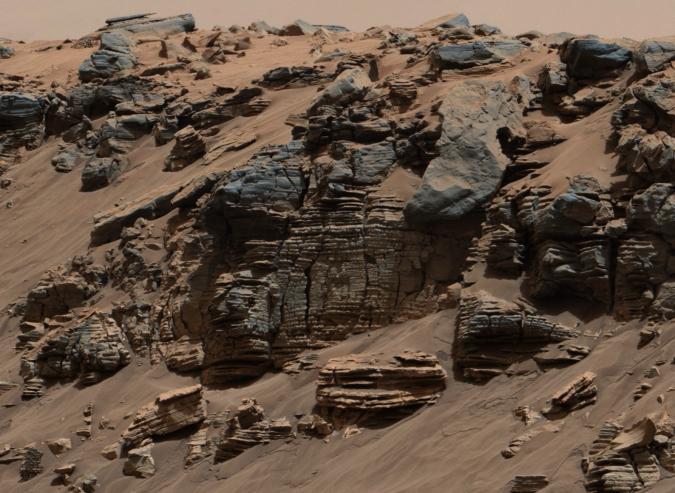Rover findings indicate stratified lake on ancient Mars

Sedimentary Signs of a Martian Lakebed (Shallow Part): This evenly layered rock imaged in 2014 by the Mastcam on NASA's Curiosity Mars rover shows a pattern typical of a lake-floor sedimentary deposit near where flowing water entered a lake. Shallow and deep parts of an ancient Martian lake left different clues in mudstone formed from lakebed deposits. Credit: NASA/JPL-Caltech/MSSS
A long-lasting lake on ancient Mars provided stable environmental conditions that differed significantly from one part of the lake to another, according to a comprehensive look at findings from the first three-and-a-half years of NASA's Curiosity rover mission. While previous work had revealed the presence of a lake more than three billion years ago in Mars' Gale Crater, this study defines the lake's chemical conditions and uses Curiosity's powerful payload to determine that the lake was stratified.
Stratified bodies of water exhibit sharp chemical or physical differences between deep water and shallow water. In Gale's lake, the shallow water was richer in oxidants than deeper water was.
“We're learning that in parts of the lake and at certain times, the water carried more oxygen,” said Roger Wiens, a planetary scientist at Los Alamos National Laboratory and co-author of the study, published today in the journal Science. “This matters because it affects what minerals are deposited in the sediments, and also because oxygen is important for life. But we have to remember that at the time of Gale Lake, life on our planet had not yet adapted to using oxygen–photosynthesis had not yet been invented. Instead, the oxidation state of certain elements like manganese or iron may have been more important for life, if it ever existed on Mars. These oxidation states would be controlled by the dissolved oxygen content of the water.”
“These were very different, co-existing environments in the same lake,” said Joel Hurowitz of Stony Brook University, lead author of the report. “This type of oxidant stratification is a common feature of lakes on Earth, and now we've found it on Mars. The diversity of environments in this Martian lake would have provided multiple opportunities for different types of microbes to survive.”
Whether Mars has ever hosted any life is still unknown, but seeking signs of life on any planet, whether Earth, Mars or more-distant icy worlds, begins with reconstruction of the environment to determine if it was capable of supporting life. NASA is using Curiosity to explore habitable environments on the ancient surface of Mars.
Over more than 1,700 sols (martian days, which are 24 hours, 39 minutes long), Curiosity has traveled more than 16 km from the bottom of Gale crater part way up Mount Sharp near the center of the crater. Los Alamos National Laboratory developed the laser-shooting Chemistry and Camera (ChemCam) instrument that sits atop Curiosity in conjunction with the French space agency. Los Alamos' work on discovery-driven instruments like ChemCam stems from the Laboratory's experience building and operating more than 500 spacecraft instruments for national security. Scientists are using all the data collected by ChemCam and other on-board instruments to put together a more complete picture of the geological history of Mars.
###
About Los Alamos National Laboratory
Los Alamos National Laboratory, a multidisciplinary research institution engaged in strategic science on behalf of national security, is operated by Los Alamos National Security, LLC, a team composed of Bechtel National, the University of California, BWXT Government Group and URS, an AECOM company, for the Department of Energy's National Nuclear Security Administration.
Los Alamos enhances national security by ensuring the safety and reliability of the U.S. nuclear stockpile, developing technologies to reduce threats from weapons of mass destruction and solving problems related to energy, environment, infrastructure, health and global security concerns.
Media Contact
All latest news from the category: Physics and Astronomy
This area deals with the fundamental laws and building blocks of nature and how they interact, the properties and the behavior of matter, and research into space and time and their structures.
innovations-report provides in-depth reports and articles on subjects such as astrophysics, laser technologies, nuclear, quantum, particle and solid-state physics, nanotechnologies, planetary research and findings (Mars, Venus) and developments related to the Hubble Telescope.
Newest articles

NASA: Mystery of life’s handedness deepens
The mystery of why life uses molecules with specific orientations has deepened with a NASA-funded discovery that RNA — a key molecule thought to have potentially held the instructions for…

What are the effects of historic lithium mining on water quality?
Study reveals low levels of common contaminants but high levels of other elements in waters associated with an abandoned lithium mine. Lithium ore and mining waste from a historic lithium…

Quantum-inspired design boosts efficiency of heat-to-electricity conversion
Rice engineers take unconventional route to improving thermophotovoltaic systems. Researchers at Rice University have found a new way to improve a key element of thermophotovoltaic (TPV) systems, which convert heat…



